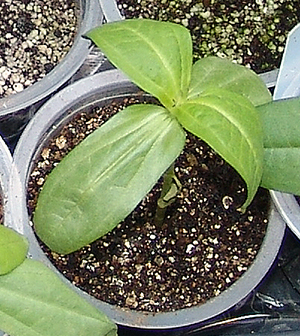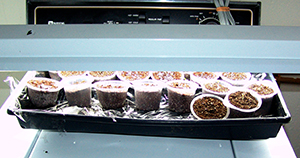Growing Your Own Seeds: How to set up your lights
Return to Miscellaneous Agent Articles

 As a child many of us had our first experience of starting plants from seeds. Think back to the marigold in a milk carton on the windowsill. The result was a long, lanky plant that did not look like anything grown professionally in a greenhouse.
As a child many of us had our first experience of starting plants from seeds. Think back to the marigold in a milk carton on the windowsill. The result was a long, lanky plant that did not look like anything grown professionally in a greenhouse.
Starting quality transplants at home where low light is an issue is not difficult. Stocky transplants require more light than even the brightest window. Once you know the trick you can grow a wide range of garden plants with just a little care.
Light it up
Growing transplants requires bright light which is not available in the home. The secret is to provide artificial light. Shop lights are widely available and economical. They provide the necessary light source. Standard shop lights have fluorescent tubes. Newer models now come in a wide range of LED styles. Either style works for growing transplants if a few rules are followed for getting the most out of the light source.
Let it shine
There are two keys to using shop lights. The first is duration of light. In order for the developing seedlings to get enough light the fixture must be shining at least sixteen hours a day. Better yet, leave them on twenty four hours. Normal sunlight does not shine that long, but sunlight is far brighter than the shop lights. Compensate for this lower light level by lighting up the plants for a longer period of time.
Keep it close
The second key to success is brightness. As the light moves away from the source the number of foot candles decreases. Short, stocky transplants are produced under the highest intensity of light. Remember back to the school project when the result was long and straggly? That is because the plants were stretching for the light.
The light source should be no further away than four to six inches from the top of the growing plants. Keeping the lamps this close increases the amount of light produced which keeps the plants compact. The supports for the light fixture need to be mounted in such a way that the lights can be lowered at first but then raised as the plants grow. An adjustable chain or some other system works fine.
Skip the expensive “Grow Lights”
It is this combination of long periods of light and high intensity that allows basic shop lights to serve as grow lights. There are more expensive grow light fixtures and bulbs on the market but they provide little added benefit. In order for them to be effective the same rules apply.
The only advantage of grow lights is they provide a wider color spectrum which is important for flowering and fruiting. This spectrum is not necessary for short term crops like transplants.
Now is the time to begin the process of starting your seeds. It is a great way to get new plant varieties and have a little fun in the process during the winter months.
Videos

Have questions? The Garden Hotline is staffed by trained EMG volunteers and Extension staff who will assist you with questions.
Phone: (913) 715-7050
Email: garden.help@jocogov.org